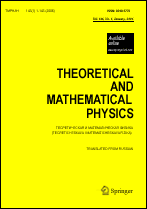|
Variational approach for studying the resistance of simple disordered metals
T. V. Shvets, V. T. Shvets
The Odessa~State Academy of Refrigeration, Odessa, Ukraine
Abstract:
Based on the variational principle, we obtain an expression for the resistance coefficient of simple disordered metals that is valid in the fourth order of the perturbation theory with respect to the electron–ion interaction. We assume that the ion subsystem is static and do not take temperature corrections into account. The decoupling parameters of higher-order Green's functions appearing in the derivation of the quantum kinetic equation are chosen from the condition that the Boltzmann equation and the quantum kinetic equation coincide in the lowest order of the perturbation theory. Calculating the resistance of a disordered metal reduces to seeking the minimum of the corresponding functional. Such an approach allows calculating, for the first time, the contribution of crossed scattering to the resistivity of disordered metals in the low-temperature limit. The known results are reproduced in the second and third orders of the perturbation theory. We show that in the fourth and higher orders, the resistance coefficient can be expressed not only in terms of the relaxation time but also in terms of the density of states of the electron gas interacting with the ions.
Keywords:
variational method, Green's function method, resistivity, perturbation theory, quantum kinetic equation.
Received: 19.06.2010
Revised: 11.09.2010
Citation:
T. V. Shvets, V. T. Shvets, “Variational approach for studying the resistance of simple disordered metals”, TMF, 166:2 (2011), 282–298; Theoret. and Math. Phys., 166:2 (2011), 244–258
Linking options:
https://www.mathnet.ru/eng/tmf6610https://doi.org/10.4213/tmf6610 https://www.mathnet.ru/eng/tmf/v166/i2/p282
|


| Statistics & downloads: |
| Abstract page: | 375 | | Full-text PDF : | 181 | | References: | 60 | | First page: | 21 |
|




 Contact us:
Contact us: Terms of Use
Terms of Use
 Registration to the website
Registration to the website Logotypes
Logotypes








 Citation in format
Citation in format 